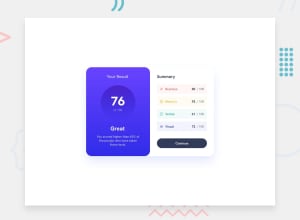
Design comparison
Solution retrospective
I am most proud of completing this solution. It was really fun and it is evident that I have work to do. Next time I'd like to get the layout on point .
What challenges did you encounter, and how did you overcome them?I had some problems with gradient colors. I saw the colors that I was supposed to use for the solution and I remembered using linear-gradient() for the results div and I wasn't getting the color that I anticipated. I realized that there is a 4th parameter that depicts the opacity of the color. Knowing this helped me move forward.
What specific areas of your project would you like help with?I would like help on the layout part of this project. They're not the same and I would like feedback to know what to do next time.
Community feedback
- @huyphan2210Posted 2 months ago
Hi, Chrision Wynaar,
I reviewed your solution, and here are a few of my thoughts:
- I noticed that in both this solution and your Blog Preview Card solution, the section with the class
.all-contentis the only child of the<body>element. To simplify, consider applying the.all-contentclass directly to the<body>and removing the<section>tag. This reduces unnecessary markup, making the structure cleaner. - The
.all-contentclass currently haswidth: 100%andmin-height: 100vh. However,width: 100%isn’t needed because<section>(and the<body>, if you apply the class there) is a block-level element, which automatically takes up the full width of its parent by default. It’s still true even if you move the class to the<body>. It’s better to applymin-height: 100vhto the<body>to ensure the content always covers the full viewport height, especially for pages with less content. - Your
<body>doesn’t include any of the semantic tags like<header>,<main>, or<footer>. It’s good practice to use these tags for accessibility and semantic clarity. You could apply the.all-contentclass to the<body>, as I mentioned earlier, and change the.containerto a<main>element instead of a<div>. Similarly, your.attributionsection could be a<footer>instead of a<div>. These semantic tags help screen readers and search engines better understand the structure and purpose of each section. - You mentioned the layout doesn’t match the design, but you didn’t specify what’s off. I assume you’re referring to the width of the summary. You’ve set the
.containerwidth to 35%, meaning it will take up 35% of its parent’s width (in this case,.all-content, which spans the full viewport). The issue arises when the viewport is too small, causing the.containerto shrink and the content to overlap or overflow. I noticed you have a media query for viewports 600px wide and below. Consider adding more media queries for larger viewports or setting amin-widthon the.containerto prevent it from shrinking too much.
Hope this helps!
Marked as helpful0 - I noticed that in both this solution and your Blog Preview Card solution, the section with the class
Please log in to post a comment
Log in with GitHubJoin our Discord community
Join thousands of Frontend Mentor community members taking the challenges, sharing resources, helping each other, and chatting about all things front-end!
Join our Discord
